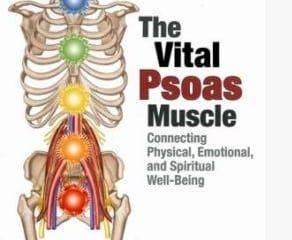
The "Muscle of the Soul" can stimulate your fear and anxiety!
The iliopsoas is one of the large and powerful muscles that is often referred to as the deepest core or yoga therapist or "muscle of the soul." This stabilizing core (the muscle), located near the hip bone, affects mobility, structural balance, joint function, flexibility, and more. In addition to the function of keeping the body upright and in motion, the iliopsoas allows you to cope kinesically at every moment. Especially when the body is stretched and tense, the logonopsiitis allows the body to release from them. Research shows that the iliac crest is vital to our psychological well-being in addition to structural health.

Where is the iliopsoas?
The iliopsoas is the main muscle involved in physical stability. It runs from the legs to the spine and is the only muscle that connects the legs to the spine. The muscle extends outside the 12 thoracic vertebrae, follows down the five lumbar vertebrae and attaches to the top of the femur.

The connectivity
In addition to connecting the legs and spine, the ilium is directly connected to the diaphragm. Breathing is regulated by the diaphragm, the point where many physical symptoms are related to fear and anxiety. You believe this is due to the direct connection between the iliac crest and the most ancient part of the brainstem and spinal cord, called the reptilian brain.
It is said that long before spoken language or the organizational ability of the cortex developed, the reptilian brain was known for its survival instincts, maintaining an essential core for our brain function. The rhythms we live in today are fast, competitive and imperative, having the hippocampus in a constant state of "fight or flight".
Issues related to chronic stress and iliopsoas
Trapped in a constant state of "flight or fight", the iliac crest is in tension almost from the moment of birth. As pointed out, this situation is aggravated by many things in the modern lifestyle, such as car seats that compress with our clothes, chairs and shoes that distort our posture and restrict natural movements. These further contract the iliac crest. This lifelong challenge of chronic stress that indirectly affects the iliopsoas can lead to many back problems, hip or knee pain, even digestive problems and breathing disorders. The above is a major reason why people suffer from chronic physical pain.
The body isn't the only part of you that suffers from chronic iliopsoas tension. The iliopsoas is much more than a muscle used for stability. It affects every aspect of life, from how you feel, how you see the world, and even how we treat others. A variety of
problems that have been associated with chronic iliopsoas tension, can negatively affect our emotional state, can affect our interpersonal relationships, and this can affect our overall satisfaction with life. Realizing that we have a healthy hip is important for emotional well-being as well as physical health. Ensuring this is the first step in giving this muscle the attention it deserves.
So if you're suffering from back pain or anxiety, knee tension, or exhaustion, there's a good chance a tight and tight iliopsoas is affecting your woes.
The fear
It is a feeling that manifests itself in the most unusual way and can "lock" physical and emotional tension in the body. By rebalancing the iliopsoas, it is possible to have a profound effect on releasing the fear of life, and thus improve both your physical and mental well-being. You will feel a greater sense of inner peace, along with less muscle pain and strain.
The connection with the energetic body
By lengthening the lagopsoite, you rely on the healing to revitalize and balance energy, which allows you to feel more present in the moment. The proper structural stability afforded by a healthy iliac crest allows power to flow unhindered throughout the body, allowing for the proper distribution of vital energy. When the body can properly support the body itself, movement is less restricted and requires less effort, leaving the body more energetic, more vital.
Ancient wisdom for modern times
Our understanding of the functionality of the hippocampus is not new knowledge at all. In reality, this is more like ancient wisdom that has been lost or discarded over time. Yoga shows us that the ancient gurus understood the importance of releasing the contraction of the iliopsoas muscle.
The ancient yoga of breaths and postures, now practiced around the world, focus on lengthening and releasing the iliopsoas muscle and restoring comfort and balance to the entire body. With years and steady practice, you can learn how to isolate this muscle, which can be very helpful in treatments in the long run.
In conclusion, yoga is a great way to assess iliopsoas health.
Physiol Physiotherapy - Pilates - Yoga

No Comments